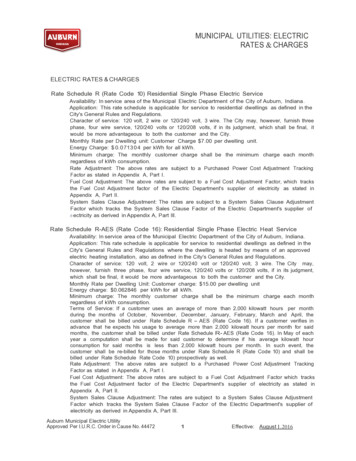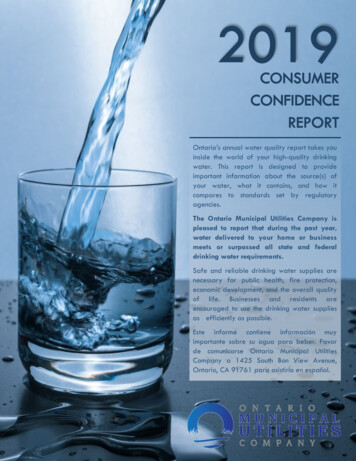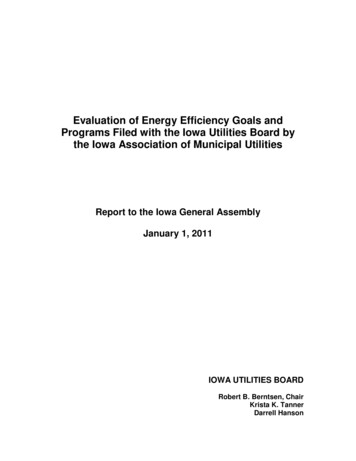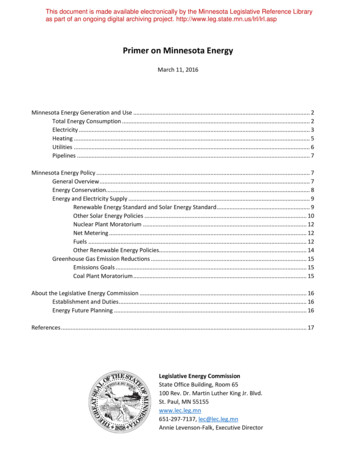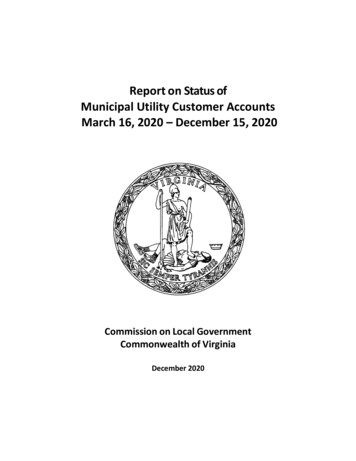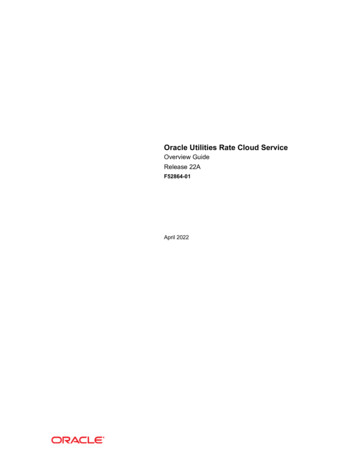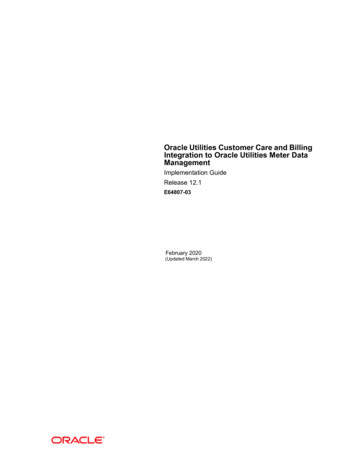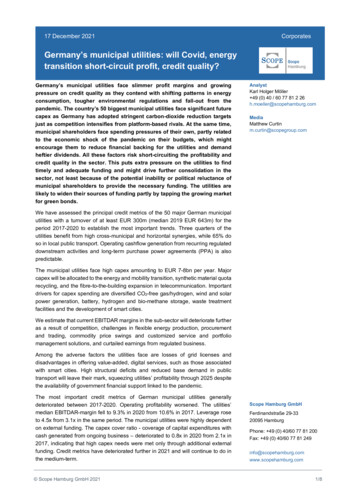
Transcription
17 December 2021CorporatesGermany’s municipal utilities: will Covid, energytransition short-circuit profit, credit quality?Germany’s municipal utilities face slimmer profit margins and growingpressure on credit quality as they contend with shifting patterns in energyconsumption, tougher environmental regulations and fall-out from thepandemic. The country’s 50 biggest municipal utilities face significant futurecapex as Germany has adopted stringent carbon-dioxide reduction targetsjust as competition intensifies from platform-based rivals. At the same time,municipal shareholders face spending pressures of their own, partly relatedto the economic shock of the pandemic on their budgets, which mightencourage them to reduce financial backing for the utilities and demandheftier dividends. All these factors risk short-circuiting the profitability andcredit quality in the sector. This puts extra pressure on the utilities to findtimely and adequate funding and might drive further consolidation in thesector, not least because of the potential inability or political reluctance ofmunicipal shareholders to provide the necessary funding. The utilities arelikely to widen their sources of funding partly by tapping the growing marketfor green bonds.AnalystKarl Holger Möller 49 (0) 40 / 60 77 81 2 26h.moeller@scopehamburg.comMediaMatthew Curtinm.curtin@scopegroup.comWe have assessed the principal credit metrics of the 50 major German municipalutilities with a turnover of at least EUR 300m (median 2019 EUR 643m) for theperiod 2017-2020 to establish the most important trends. Three quarters of theutilities benefit from high cross-municipal and horizontal synergies, while 65% doso in local public transport. Operating cashflow generation from recurring regulateddownstream activities and long-term purchase power agreements (PPA) is alsopredictable.The municipal utilities face high capex amounting to EUR 7-8bn per year. Majorcapex will be allocated to the energy and mobility transition, synthetic material quotarecycling, and the fibre-to-the-building expansion in telecommunication. Importantdrivers for capex spending are diversified CO2-free gas/hydrogen, wind and solarpower generation, battery, hydrogen and bio-methane storage, waste treatmentfacilities and the development of smart cities.We estimate that current EBITDAR margins in the sub-sector will deteriorate furtheras a result of competition, challenges in flexible energy production, procurementand trading, commodity price swings and customized service and portfoliomanagement solutions, and curtailed earnings from regulated business.Among the adverse factors the utilities face are losses of grid licenses anddisadvantages in offering value-added, digital services, such as those associatedwith smart cities. High structural deficits and reduced base demand in publictransport will leave their mark, squeezing utilities’ profitability through 2025 despitethe availability of government financial support linked to the pandemic.The most important credit metrics of German municipal utilities generallydeteriorated between 2017-2020. Operating profitability worsened. The utilities’median EBITDAR-margin fell to 9.3% in 2020 from 10.6% in 2017. Leverage roseto 4.5x from 3.1x in the same period. The municipal utilities were highly dependenton external funding. The capex cover ratio - coverage of capital expenditures withcash generated from ongoing business – deteriorated to 0.8x in 2020 from 2.1x in2017, indicating that high capex needs were met only through additional externalfunding. Credit metrics have deteriorated further in 2021 and will continue to do inthe medium-term. Scope Hamburg GmbH 2021Scope Hamburg GmbHFerdinandstraße 29-3320095 HamburgPhone: 49 (0) 40/60 77 81 200Fax: 49 (0) 40/60 77 81 249info@scopehamburg.comwww.scopehamburg.com1/8
Accelerated transition entails short circuitcircuit risks in municipal utilities’ fundingFigure 1: major German municipal utilities: horizontal segmentdiversification (revenue shares)8%4%5%83%WaterLocal public transportEnergyOthersSource: Scope Hamburg: division shares of revenues 2019 for the major domestic 50 municipal utilitieswith group revenues EUR 300mEnergy segment as principaldriver of revenues growthThe mandates of the leading national municipal utilities are characterised bystrong local market shares, a high degree of homogeneity, mainly regulateddownstream (energy segment partly upstream) activities and high exposure toresidential customers. The main fields of operation of municipal utilities areenergy procurement, production, distribution (B2B and B2C) to customers,services, and trading activities. The infrastructure providers (apart from theenergy division) are mainly wholly owned by municipalities with their own(de)centralized production and sewage/waste treatment facilities, network withmostly long-term concessions and public transport fleet. In this analysis, we focuson the significant revenue and profit drivers as these relate to the energy, drinkingwater/sewage, and local public transport supply mandates (Figure 1).Increasing pressure on profitabilityEBITDAR margins havefallen continuously in theperiod 2017-2021eThe operating profitability of municipal utilities in our sample, as measured by theEBITDAR margin, decreased to 9.3% in 2020 from 10.6% in 2017 and weforecast a further margin compression to 9.1% in 2021 (figure 2). Deterioratingoperating profit margins are a reflection of reduced energy and (publictransportation) mobility consumption in 2020, either related to effects of thecorona pandemic or seasonal weather impacts. In addition, the transformation ofmunicipal utilities to lower carbon emissions has left its mark. Negative margineffects were only partly compensated through price increases for electricity,heating and water or higher public subsidies.Profitability impaired bypartly by increasingcompetitionThe increasing market shares of global technology groups (such as Alphabet,Amazon, Meta, Microsoft, Tencent) and national market leaders (such as E.ONSE, Uniper SE, EnBW AG, RWE AG with start-up partners) with cross-sector anddisruptive approaches will increase the pressure on the traditional businessmodels of municipal utilities. Global technology groups and national marketleaders extend their positioning with both cross-regional and size-dependentsynergies, digital platforms, local data and vertical value-added services. Marketleaders provide smart grid solutions and platforms based on artificial intelligenceto prosumer communities to optimise their energy efficiency, feed-in and storagevolumes, and profits and to control low carbon emissions in private and publicmobility.Market leaders have competitive advantages in capital markets access andprofessional bespoke energy procurement vis-á-vis the smaller local municipal Scope Hamburg GmbH 20212/8
Accelerated transition entails short circuitcircuit risks in municipal utilities’ fundingutilities. Market leaders likewise benefit from hedging strategies including priceand volume swings (“dark doldrums”, peak loads, COVID-19-pandemic specialbusiness cycle in proprietary trading in 2020). Advantages exist for thosecompetitors due to customer solutions in smart long-term contracting (PPA, B2Bheating, cooling) and the cross-industry development of smart city solutions.Additional factors are competencies in CO2-free renewable generation andstorage media portfolios e.g. conversion green electricity into synthetic energysources (P2X) for electricity storage, electricity-based fuels, or raw materials forthe chemical industry.High market barriersprotect municipalmonopolies, but tougherregulation looming in themedium-termIncreasing competition, multi-brand strategies and (unhedged) cyclical demandand price swing risks (e.g. second half-year 2021) will further weaken themunicipal utilities’ operating profitability. Municipal utilities can partly compensateweakened EBITDAR margins thanks to the high market entry barriers tolocal/municipal markets as a result of the predominantly monopolistic marketsituation and highly locally diversified customer structures (“basic B2C supplierstatus”).The regulated profits of the distribution infrastructure are based on revenue-capbased tariff models with predictable and recurring operating cash flows. Theenergy transition (4th regulatory period for electricity from 2023 and gasdistribution operators from 2024) will, however, further burden the limited returnsin those fields. Additional factors are reduced equity interest rates (WACC) onthe regulated asset base of new assets from 2006 (5.07%) and optimizednetwork losses. The utilities benefit from high cross-municipal (e.g. inhousecontracting, non-profit housing) and horizontal synergies (smart districts andcities). The currently stable network profits will decrease by aligned regulatoryregimes, higher expansion and maintenance and of the loss risks of grid licensesby 2025.Figure 2: major municipal utilities: revenue recovery, but continuingdecline in EBITDAR marginsSource: Scope Hamburg: adjusted (inverse depreciations of investment grants, non-recurring effects,lease and rent expenses) EBITDAR-to-revenues (medians) for the major 50 municipal utilities for theperiod 2017-2020 and trend 2021e (base 2020 representative published audited consolidated financialstatements and data for 70 % of the considered municipal utilities), no adjustments for local publictransport COVID-19 subsidies and trading gross profit. Scope Hamburg GmbH 20213/8
Accelerated transition entails short circuitcircuit risks in municipal utilities’ fundingSustainable higher deficitsin local public transportburden the profitability by2025Pandemic-related revenue shortfalls and special burdens (average decline inlocal public transport passenger volumes of 33% in 2020 yoy and 17% yoy infirst half of 2021) will be almost fully compensated by pandemic bailout fundsprovided for local public transport companies arranged by federal and stategovernments. These bailout schemes are, however, scheduled to end in 2021.An extension of support programs for local public transport or renewal of anysuch programs is currently still subject to discussions. If no new support schemesfor local public transportation operations were enacted, municipal utilities willhave to rely on additional (horizontal) segment profits, unused committed creditlines or price increases from 2022 onwards to compensate for the structuraldeficits in public transportation. Taking into account extensive price moratoria aswell as sustainable shifts to individual mobility (including expansion in use ofelectric vehicles and fast charging stations), we expect passenger volumes,(new) subscription models and services, capacity utilization and cost recoveryratios in local public transport to reach the 2019 baseline in 2025 at the earliest.The transition of thebusiness models and lowgeographical and verticaldiversification burden theprofitabilityIn 2021 municipal utilities benefit from positive seasonal weather impacts, thatcompensate negative wind-driven feed-in effects and high transition costs. Highmarket values of energy commodities enhance proprietary trading (no timelyprocurement), counterparty, portfolio management and liquidity risks (exceededlimits in OTC trading). Ambitious transition goals to reach coal phase-out andclimate targets (e.g. domestic renewable electricity share of demand 80% (prior65%) by 2030 (previously 2038)) increase substitution risks of unregulatedbusiness in the sub-sector.The utilities face higher financial risks due to the growth and transition of the baseand peak load power generation portfolio, cooperation partner synergies and theassessment of the competitive position of the (contracted) sales and tradingchannels. The municipal utilities have low (sales, renewable assets)geographical and value-added vertical diversification.Negative profitability trendin the medium-termWe expect the negative trend in operating profitability of municipal utilities tocontinue as a result of competitive pressure, and substantial costs incurred forthe transition of the energy and mobility segments (Figure 2).Figure 3: major municipal utilities: overall deteriorated capex and shortterm debt coveragesSource: Scope Hamburg: adjusted net capex (taking account of disposals and grants) operating Cashflow (OCF)-net capex (medians) and adjusted (marketable securities and equivalents and restrictedcash) liquidity and free operating cash flow (FOCF)-short-term debt (medians). Scope Hamburg GmbH 20214/8
Accelerated transition entails short circuitcircuit risks in municipal utilities’ fundingInadequate capex and short-term debt coveragesHigh growth and transitioncapex and investmentbottleneck up to 2030The leading municipal utilities such as Stadtwerke München, Stadtwerke Köln,MVV Energie, SachsenEnergie, VVG Hannover, LVV Leipzig have coordinatedlong-term strategies and forecasts with integrated smart-city developments withmunicipal shareholders up to 2030. Highly regulated safeguarding of supplyservices to customers include network stability and climate targets. Strategicgoals include investments in flexible and diversified CO2-free thermal (hydrogen)power-plants, renewable energy generation and energy storage.Development of smartmetropolitan regions and citiesAdditional capex goals include development of smart regions and cities – theRhine-Ruhr region, military bases and railroad sites - taking into considerationwith long approval procedures, demographic developments, R&D and economicforecasts. The major utilities have developed digital platforms with “one local faceto the customer” to meet demand and save costs. Efficient network and localtransport fleet upgrades reduce infrastructure investment bottlenecks.Increasing external fundingneeds by tightened regulatedregimes and e-mobilitytargetsConsumption forecasts for drinking water and treated sewage includingexpectations for a higher number of heavy rain and drought periods requireconsiderable expansion and refurbishment investments in water infrastructure.There are increased investment and operator risks due to stricter ecologicalrequirements related to of the 4th treatment stage and in mono-incineration withash storage and phosphorus recovery in sewage sludge recycling.In the mobility segment, the high expansion and upgrade investments for trackexpansion in the main roads and e- and hydrogen fleets are partly financed byfederal-state funding to achieve the ambitious e-mobility goals.Inadequate capex coverageand short-term debt maturitieslimit shareholders’ dividendsThe ownership structure of municipal utilities together with increasing dividendexpectations, high capital intensity, regulatory framework and the low cash flowshare of (digital) value-added services limit the adaptability of the businessmodels. We observe inadequate funding of short-term financial debt at municipalutilities. In 2020, only 80% of short-term financial debt was covered with cash atbank or other unrestricted and immediately convertible cash-near assets. Weexpect the dependence of municipal utilities on short-term external financing toeven deteriorate further in the medium term. (Figure 3).Figure 4: major municipal utilities: leverage and interest cover worsensSource: Scope Hamburg: adjusted leverage (unfunded pension, decommissioning and retirementprovisions and operate lease obligations) net debt-to-EBITDAR (medians) and adjusted EBITDARinterest cover (net paid interests, medians). Scope Hamburg GmbH 20215/8
Accelerated transition entails short circuitcircuit risks in municipal utilities’ fundingLeverage and interest cover will deteriorate due to expansionand transition of the business modelsHigh funding needs for peakcapexThe municipal utilities face high net capex amounting to EUR 7-8bn (taking intoaccount disposal proceeds and investment grants; previous years EUR 4-6bn)per year by 2025e to accelerate the transition of its energy, recycling and sewagetreatment, mobility and telecommunication segments.Highly regulated positive cash flows in the energy and water segments anddisposals of capital intensity non-core activities and share deals will stabilize thebusiness risk profiles and reduce external funding needs.High financial requirementsfor decommissioning ofpower plantsStructural transition capex for projects such as the coalfields in the Ruhr andLusatia regions or decommissioning nuclear power plants, including technicalretirement risks combined with climate targets, raise the funding needs for theenergy, water and mobility segments of selected municipal utilities players.Deteriorated leverage andinterest coverThe leverage and interest cover will weaken due to increased financing needsfor growth, transition, regulatory and decommissioning capex. Municipal utilitiesface large capital investment/capex needs in the medium-term resulting from: coal/nuclear decommissioning commissioning of CO2-free thermal (hydrogen) power-plants expansion battery, hydrogen and bio-methane storages permitting, project planning and long-termonshore/offshore wind and solar farms portfolios expansion fibre-to-the-building connections expansion smart and hydrogen and refurbishment distribution networkmarketingof upgrading e-mobility fleets commissioning synthetic material recycling and waste treatmentfacilities and mono-incineration with ash storage and phosphorusrecovery in sewage sludge recycling digital customized platforms development of smart districts, cities and metropolitan areasWith reduced public support, low internal financing capability, and the expecteddeterioration of operating profitability, we foresee a further deterioration of creditmetrics for municipal utilities.The market-leading institutional investors provide green bonds for infrastructurefunding based on Investment Grade Ratings and ESG performance KPIs.Inadequate cash flows and liquidity reserves, transition risks of the businessmodels, higher interest rates and extensive dividend policy will negatively impactthe assessment of municipal utility credit risks (Figure 4).Historically weak internal cash generation from ongoing business is expected toweaken, further reflecting the negative effects on operating profitability, and,possibly, higher interest burdens from increasing indebtedness. Scope Hamburg GmbH 20216/8
Accelerated transition entails short circuitcircuit risks in municipal utilities’ fundingFigure 5: major municipal utilities: deleveraging 8201920202021eSource: Scope Hamburg: adjusted FFO (depreciation component of lease, paid taxes and net interests,medians) -to-net debt (medians).Deteriorating deleveragingpotential entail higher shortcircuit risks in fundingThe question is whether adequate (not restricted) liquidity reserves, unusedcommitted credit lines, certain disposals and financial sources will cover the shortand medium-term maturities of interest-bearing liabilities. Transition risks of thebusiness models, higher interest rates and more generous dividends will leavenotably negative marks on municipal utility credit risks (Figure 5).Higher short circuit risks in adequate funding for financiallydistressed municipal utilitiesAre financially distressedmunicipal utilities stillappropriately supported?The question is whether financially distressed municipal utilities are stillappropriately supported by timely extraordinary shareholders’ cash injectionsand traditional financial sources, e.g. syndicated bank loans, in spite of shortcircuiting the profitability and credit metrics. Inability or political reluctance ofmunicipal shareholders to provide for timely funding of local municipal utilitiesmay lead to an accelerated sub-sector’s market consolidation.This publication does not constitute a rating action for any of the companiesmentioned.Scope Ratings GmbH and Scope Ratings UK Limited apply the samemethodologies/models and key rating assumptions for their credit rating services.Scope Hamburg GmbH’s methodologies/models and key rating assumptions aredifferent from those of Scope Ratings GmbH and Scope Ratings UK Limited. Scope Hamburg GmbH 20217/8
Accelerated transition entails short circuitcircuit risks in municipal utilities’ fundingDisclaimer 2021 Scope Hamburg GmbH (“SHG”) and/or its licensors and affiliates. All rights reserved.CREDIT RATINGS ISSUED BY SHG ARE SHG’S CURRENT OPINIONS OF THE RELATIVE FUTURE CREDIT RISK OF ENTITIES,CREDIT COMMITMENTS, OR DEBT OR DEBT-LIKE SECURITIES, AND SHG’S PUBLICATIONS MAY INCLUDE SHG’S CURRENTOPINIONS OF THE RELATIVE FUTURE CREDIT RISK OF ENTITIES, CREDIT COMMITMENTS, OR DEBT OR DEBT-LIKESECURITIES. SHG DEFINES CREDIT RISK AS THE RISK THAT AN ENTITY MAY NOT MEET ITS CONTRACTUAL, FINANCIALOBLIGATIONS AS THEY COME DUE AND, IN THE CASE OF ISSUANCE-LEVEL CREDIT RATINGS, ANY ESTIMATED FINANCIALLOSS IN THE EVENT OF DEFAULT. CREDIT RATINGS DO NOT ADDRESS ANY OTHER RISK, INCLUDING BUT NOT LIMITED TO:LIQUIDITY RISK, MARKET VALUE RISK, OR PRICE VOLATILITY. CREDIT RATINGS AND SHG’S OPINIONS INCLUDED IN SHG’SPUBLICATIONS ARE NOT STATEMENTS OF CURRENT OR HISTORICAL FACT. CREDIT RATINGS AND SHG’S PUBLICATIONSARE NEITHER A PROSPECTUS NOR A SUBSTITUTE FOR INFORMATION ASSEMBLED AND PRESENTED BY COMPANIESOR ISSUERS FOR INVESTORS REGARDING THE PURCHASE OF A SECURITY OR FOR ASSESSING THE CREDITWORTHINESSOF A RATED ENTITY. CREDIT RATINGS AND SHG’S PUBLICATIONS DO NOT CONSTITUTE OR PROVIDE INVESTMENT ORFINANCIAL ADVICE, AND DO NOT PROVIDE RECOMMENDATIONS TO PURCHASE, SELL, OR HOLD PARTICULAR SECURITIES.NEITHER CREDIT RATINGS NOR SHG’S PUBLICATIONS COMMENT ON THE SUITABILITY OF AN INVESTMENT FOR ANYPARTICULAR INVESTOR. SHG ISSUES ITS CREDIT RATINGS AND PUBLISHES ITS PUBLICATIONS WITH THE EXPECTATIONAND UNDERSTANDING THAT EACH INVESTOR WILL, WITH DUE CARE, CONDUCT ITS OWN INDEPENDENT ANALYSES,CREDIT ASSESSMENTS AND OTHER VERIFICATIONS AND EVALUATIONS OF EACH SECURITY THAT IS UNDERCONSIDERATION FOR PURCHASE, HOLDING, OR SALE.SHG’S CREDIT RATINGS AND SHG’S PUBLICATIONS ARE NOT INTENDED FOR USE BY RETAIL INVESTORS AND IT WOULDBE RECKLESS AND INAPPROPRIATE FOR RETAIL INVESTORS TO USE SHG’S CREDIT RATINGS OR SHG’S PUBLICATIONSWHEN MAKING AN INVESTMENT DECISION. IF IN DOUBT YOU SHOULD CONTACT YOUR FINANCIAL OR OTHERPROFESSIONAL ADVISER.ALL INFORMATION CONTAINED HEREIN IS PROTECTED BY LAW, INCLUDING BUT NOT LIMITED TO, COPYRIGHT LAW, ANDNONE OF SUCH INFORMATION MAY BE COPIED OR OTHERWISE REPRODUCED, REPACKAGED, FURTHER TRANSMITTED,TRANSFERRED, DISSEMINATED, REDISTRIBUTED OR RESOLD, OR STORED FOR SUBSEQUENT USE FOR ANY SUCHPURPOSE, IN WHOLE OR IN PART, IN ANY FORM OR MANNER OR BY ANY MEANS WHATSOEVER, BY ANY PERSON WITHOUTSHG’S PRIOR WRITTEN CONSENT.All information contained herein is obtained by SHG from sources believed by it to be accurate and reliable. Because of the possibility of humanor mechanical error as well as other factors, however, all information contained herein is provided “AS IS” without warranty of any kind. SHGadopts all necessary measures so that the information it uses in assigning a credit rating is of sufficient quality and from sources SHG considersto be reliable including, when appropriate, independent third-party sources. However, SHG is not an auditor and cannot in every instanceindependently verify or validate information received in the rating process or in preparing the SHG publications.Please note that summaries of contracts, laws and other documents contained in any SHG publication, rating report or other materialscannot replace careful study of the relevant complete texts.SHG and its directors, officers, employees, agents, representatives, licensors and suppliers disclaim liability to any person or entity forany indirect, special, consequential, or incidental losses or damages whatsoever arising from or in connection with the informationcontained herein or the use of or inability to use any such information, even if SHG or any of its directors, officers, employees, agents,representatives, licensors or suppliers is advised in advance of the possibility of such losses or damages, including but not limited to:(a) any loss of present or prospective profits or (b) any loss or damage arising where the relevant financial instrument is not the subjectof a particular credit rating assigned by SHG. The limitations do not apply to the extent that fraud, intent or any other type of liabilitycannot be excluded and/or limited under applicable law.SHG and its directors, officers, employees, agents, representatives, licensors and suppliers disclaim liability for any direct orcompensatory losses or damages caused to any person or entity, on the part of, or any contingency within or beyond the control of,SHG or any of its directors, officers, employees, agents, representatives, licensors or suppliers, arising from or in connection with theinformation contained herein or the use of or inability to use any such information. The limitations do not apply to the extent that fraud,intent or any other type of liability cannot be excluded and/or limited under applicable law.NO WARRANTY, EXPRESS OR IMPLIED, AS TO THE ACCURACY, TIMELINESS, COMPLETENESS, MERCHANTABILITY ORFITNESS FOR ANY PARTICULAR PURPOSE OF ANY SUCH RATING OR OTHER OPINION OR INFORMATION IS GIVEN OR MADEBY SHG IN ANY FORM OR MANNER WHATSOEVER.The dissemination and use of an SHG rating report may be prohibited by law in certain jurisdictions. Any persons who come into thepossession of such information should inquire about and comply with any prohibitions that may be in place. SHG assumes no liability ofany kind with respect to such dissemination and use of any rating in any jurisdiction whatsoever.Scope Hamburg GmbH Scope Hamburg GmbH 20218/8
lease and rent expenses) EBITDAto-R-revenues (medians) for the major 50 municipal utilities for the period 2017-2020 and trend 2021e (base 2020 representative published audited consolidated financial statements and data for 70 % of the considered municipal utilities), no adjustments for local public

